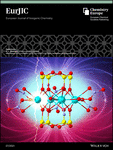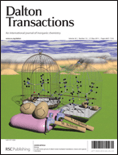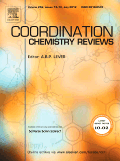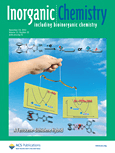
EUROPEAN JOURNAL OF INORGANIC CHEMISTRY
Scope & Guideline
Pioneering Discoveries in Inorganic Science
Introduction
Aims and Scopes
- Coordination Chemistry:
Research articles often explore the synthesis and properties of coordination complexes, particularly those involving transition and lanthanide metals. These studies include investigations of ligand design, complex stability, and reactivity. - Organometallic Chemistry:
The journal features studies on organometallic compounds, including their synthesis, structure, and catalytic applications. This includes work on metal-catalyzed reactions and the development of new organometallic frameworks. - Materials Science:
Papers frequently discuss the development and characterization of novel inorganic materials, such as metal-organic frameworks (MOFs), nanomaterials, and luminescent compounds, focusing on their potential applications in catalysis, sensing, and energy conversion. - Theoretical and Computational Studies:
The journal includes significant contributions in computational chemistry, providing insights into the electronic structure and reactivity of inorganic compounds. This includes density functional theory (DFT) studies and molecular dynamics simulations. - Biological Inorganic Chemistry:
Research in this area examines the interactions of metal complexes with biological systems, including the design of metal-based drugs and the study of metalloproteins.
Trending and Emerging
- Sustainable and Green Chemistry:
There is a growing trend towards research that emphasizes sustainable practices in synthesis and application, including the development of green catalysts and processes for environmental remediation. - Nanomaterials and Nanocomposites:
Research focusing on the synthesis and application of nanomaterials, particularly in catalysis and energy storage, is on the rise. This includes studies on metal nanoparticles and their composites with organic or inorganic materials. - Photocatalysis and Solar Energy Conversion:
The journal is increasingly publishing articles on photocatalytic systems and their applications in energy conversion, particularly for CO2 reduction and water splitting, reflecting the global push towards renewable energy sources. - Multifunctional Materials:
There is a notable increase in the publication of studies on multifunctional materials that combine properties such as magnetism, luminescence, and catalytic activity, showcasing their potential in advanced applications. - Biologically Relevant Inorganic Chemistry:
Research exploring the interactions of inorganic compounds with biological systems, including drug design and biomimetic systems, is gaining prominence as the field increasingly intersects with medicinal chemistry.
Declining or Waning
- Classical Coordination Complexes:
There has been a noticeable decline in studies focusing solely on classical coordination complexes without significant new findings or applications. Instead, the trend has shifted towards more complex systems involving multiple metal centers or innovative ligand designs. - Traditional Organometallic Reactions:
Research on well-established organometallic reactions, such as simple cross-coupling or hydrosilylation, has become less prominent, as researchers explore more complex catalytic systems or novel reaction mechanisms. - Basic Inorganic Synthesis:
Papers focusing on basic inorganic synthesis techniques without novel applications or insights are becoming less frequent, as the journal emphasizes studies that demonstrate clear advancements in methodology or significant findings.
Similar Journals

DALTON TRANSACTIONS
Championing Integrity in Scientific DiscoveryDALTON TRANSACTIONS, published by the esteemed Royal Society of Chemistry, is a premier journal in the field of Inorganic Chemistry, recognized for its significant contributions to advancing research and scholarship since its inception in 2002. With an impressive Impact Factor and ranked in the Q1 category, it holds a notable position at Rank #21 out of 79 within its Scopus category, highlighting its reputation for excellence and influence in the scientific community. This journal provides a platform for disseminating high-quality research, reviews, and communications related to all aspects of inorganic chemistry, fostering collaboration and innovation among researchers, professionals, and students alike. Although it does not offer open access, its robust selection process and commitment to scholarly integrity ensure that published works are of the highest standard. For those passionate about inorganic chemistry, DALTON TRANSACTIONS serves as an essential resource, fostering a deeper understanding of the field and its applications.

COORDINATION CHEMISTRY REVIEWS
Leading the Way in Coordination Chemistry ResearchCOORDINATION CHEMISTRY REVIEWS is a premier academic journal published by ELSEVIER SCIENCE SA, specializing in the interdisciplinary field of coordination chemistry. Established in 1966 and running until 2025, the journal boasts an impressive reputation, having achieved Q1 quartile rankings in categories such as Inorganic Chemistry, Materials Chemistry, and Physical and Theoretical Chemistry. It holds a remarkable position in Scopus rankings, being ranked #1 in both Physical and Theoretical Chemistry and Inorganic Chemistry, indicating its significance within the field. With a focus on comprehensive reviews that synthesize existing knowledge and propose future research directions, COORDINATION CHEMISTRY REVIEWS serves as an invaluable resource for researchers, professionals, and students eager to stay at the forefront of coordination chemistry advancements. Although not open access, the journal is accessible through various academic institutions and libraries, ensuring that cutting-edge research is available to those who seek it.

CHEMISTRY-A EUROPEAN JOURNAL
Pioneering Insights in Chemistry and CatalysisCHEMISTRY-A EUROPEAN JOURNAL is a premier academic journal published by WILEY-V C H VERLAG GMBH, specializing in the diverse fields of chemistry and catalysis, with a distinguished focus on organic chemistry. Since its inception in 1995, the journal has established itself as an authoritative resource for researchers and professionals, currently classified in Q1 in Chemistry (miscellaneous) and Organic Chemistry, reflecting its high-quality contributions to the scientific community. With an impressive impact factor and robust Scopus rankings—#33 in Organic Chemistry and #26 in Catalysis—this journal serves as a vital platform for disseminating innovative research findings and critical advancements in chemical sciences. Although not an open-access journal, it provides valuable access options for institutions, ensuring wide reach and engagement within the scientific community. As it converges into 2024, CHEMISTRY-A EUROPEAN JOURNAL remains a key resource for anyone dedicated to advancing the frontiers of chemistry research.

CHINESE JOURNAL OF STRUCTURAL CHEMISTRY
Exploring Innovations in Molecular ArchitectureThe CHINESE JOURNAL OF STRUCTURAL CHEMISTRY, published by Elsevier, stands as a vital resource in the field of structural chemistry, notably contributing to the advancement of knowledge since its inception in 1996. With its ISSN 0254-5861 and E-ISSN 0254-5861, the journal has established a firm reputation, garnering a Q2 ranking in the 2023 Chemistry (miscellaneous) category, which highlights its influence in the academic community (rank #155/408, 62nd percentile in Scopus). This journal serves as an invaluable platform for researchers and professionals by disseminating high-quality research findings, theoretical studies, and applied methodologies that address both fundamental aspects and emerging trends in structural chemistry. With contributions from distinguished scholars, it aims to foster innovation and collaboration, while providing a space for novel discoveries in the field. Although it does not currently offer Open Access, its robust content continues to attract a diverse readership eager to engage with cutting-edge scientific developments.

Chemistry-Switzerland
Catalyzing Discoveries in Chemistry from Basel to the WorldChemistry-Switzerland is an esteemed, fully Open Access journal published by MDPI, dedicated to advancing research in a broad spectrum of chemistry disciplines. Launched in 2019, the journal has established itself within the academic community, particularly as it spans critical areas such as inorganic and organic chemistry, as well as electrochemistry. Recognized for its contributions, it has achieved notable rankings, including Q2 status in Chemistry (miscellaneous) and Inorganic Chemistry, and Q3 standing in Electrochemistry and Organic Chemistry for 2023. With a commitment to disseminating high-quality research, Chemistry-Switzerland serves as an invaluable resource for researchers, professionals, and students aiming to share their discoveries with a global audience. Located in Basel, Switzerland, this journal facilitates seamless access to cutting-edge research, fostering innovation and collaboration within the vibrant field of chemistry. With this dynamic platform, the journal aims to continue its trajectory of growth and impact, inspiring the next generation of chemists.

JOURNAL OF STRUCTURAL CHEMISTRY
Unveiling the Complexities of Molecular StructuresThe JOURNAL OF STRUCTURAL CHEMISTRY, published by PLEIADES PUBLISHING INC, is a premier resource in the fields of Inorganic Chemistry, Materials Chemistry, and Physical and Theoretical Chemistry. Established in 1960, this journal has been providing a platform for groundbreaking research, facilitating the advancement of knowledge and innovation up to the year 2024. With an ISSN of 0022-4766 and an E-ISSN of 1573-8779, this journal strives to maintain high academic standards, as evidenced by its quartile rankings in 2023, where it ranks Q4 across various chemistry categories. While it currently does not offer open access, the journal's insightful articles are crucial for professionals and students seeking to enhance their understanding and expertise in structural chemistry. Subscribers can expect a comprehensive collection of peer-reviewed research, empirical findings, and theoretical discussions that contribute significantly to the scientific community. With its strong historical foundation and ongoing commitment to quality, the JOURNAL OF STRUCTURAL CHEMISTRY continues to be an essential resource for those passionate about the complexities of structural chemistry.

Inorganics
Empowering Researchers in the World of InorganicsInorganics is a vibrant, peer-reviewed Open Access journal dedicated to advancing the field of inorganic chemistry, published by MDPI since 2013. Based in Switzerland, this journal aims to provide a dynamic platform for researchers, professionals, and students to share groundbreaking findings, fostering collaboration and innovation within the global scientific community. With an impressive Q2 ranking in the category of Inorganic Chemistry as of 2023, Inorganics stands out as a significant conduit for high-quality research that spans a wide range of topics from coordination compounds to metal-organic frameworks. Its commitment to accessibility ensures that cutting-edge research can be accessed, utilized, and built upon by a diverse audience, thereby amplifying its impact. Join the conversation in Inorganics and contribute to the ever-evolving landscape of inorganic chemical research.

INORGANIC CHEMISTRY
Catalyzing Knowledge in Inorganic and Physical ChemistryInorganic Chemistry, published by the American Chemical Society, stands at the forefront of the field of inorganic and physical chemistry, boasting an impressive impact in the academic community with a 2023 classification in the Q1 quartile across multiple categories including Inorganic Chemistry and Miscellaneous Chemistry. Since its inception in 1962, this esteemed journal has been a crucial platform for disseminating groundbreaking research, innovative methodologies, and comprehensive reviews integral to understanding the complex behaviors of inorganic materials. With a ranking of #12 out of 79 in Inorganic Chemistry and #37 out of 189 in Physical and Theoretical Chemistry according to Scopus metrics, Inorganic Chemistry has established itself as a premier destination for researchers, professionals, and students alike, eager to stay abreast of pivotal developments and trends in the discipline. Despite being a subscription-based journal, its esteemed reputation and critical contributions make it essential for anyone engaged in the exploration of inorganic chemical phenomena. As it prepares to converge into a new era by 2024, the journal continues to embody excellence and innovation, fostering a dynamic exchange of ideas essential for advancing this vibrant area of science.

New Materials Compounds and Applications
Exploring Innovative Frontiers in Materials ScienceNew Materials Compounds and Applications is a pioneering journal published by JOMARD PUBLISHING, focusing on the latest advancements in materials science, particularly in the realms of analytical, inorganic, and organic chemistry. Since its inception in 2019, this journal has quickly established itself as a valuable resource for researchers and professionals seeking to explore innovative compounds and their applications across various fields. With an ISSN of 2521-7194 and an E-ISSN of 2523-4773, New Materials Compounds and Applications is indexed in Scopus, demonstrating its scholarly impact, albeit currently positioned in the Q3 and Q4 quartiles for several chemistry categories. The journal serves as a platform for disseminating research findings and fostering collaboration among scientists in Azerbaijan and beyond. Although it operates under a traditional access model, the journal aims to bridge the gap between theoretical studies and practical applications, making it essential reading for students and professionals looking to stay updated in the dynamic landscape of materials chemistry.

RUSSIAN JOURNAL OF INORGANIC CHEMISTRY
Bridging Disciplines in Inorganic and Materials ScienceThe Russian Journal of Inorganic Chemistry is a distinguished publication that delves into the fundamental and applied aspects of inorganic chemistry. Published by MAIK Nauka/Interperiodica/Springer, this journal has established itself as a vital resource for researchers, professionals, and students alike, contributing significantly to the fields of Inorganic Chemistry, Materials Science, and Physical and Theoretical Chemistry. With an ISSN of 0036-0236 and an E-ISSN of 1531-8613, the journal is indexed for easy access and citation. Though the journal currently operates under a subscription model, its commitment to disseminating high-quality research and fostering scientific discourse remains steadfast. The journal has been maintaining a consistent record since its inception, and its positioning in the Q3 quartile across various chemistry categories in 2023 underscores its relevance in the academic community. As it continues through its converged years from 1996 to 2024, the Russian Journal of Inorganic Chemistry plays a pivotal role in enhancing the understanding and advancement of inorganic chemistry, making it an indispensable tool for anyone engaged in this dynamic field.